We wanted to know it
Since mankind developped some good intelligence, we [people] immediately started to discover our world. We walked by foot until we could reach. We domesticated big animals – horses – and rode horses to reach even further, horizontally and vertically. So we reached the water. Horses could not bring us across the seas and oceans. We had to create new technology, that could carry people above the water – ships.
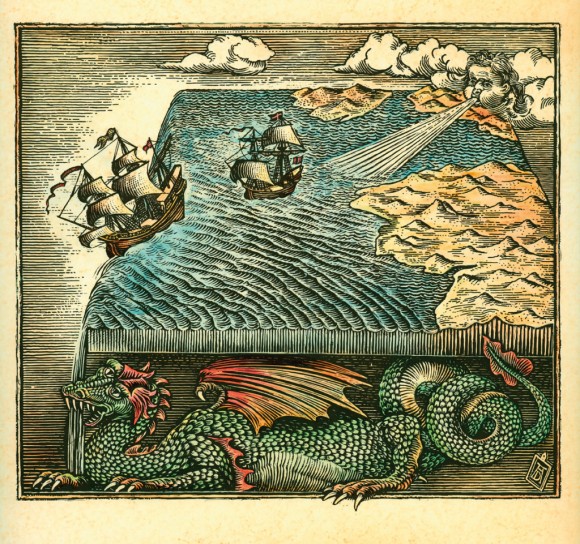
Fantasy map of a flat earth — Image by © Antar Dayal/Illustration Works/Corbis
Ship building required pretty much calculation itself. And ship only is not sufficient to get there. Some navigation needed. We developped both measurement and calulcation of wood and nails, measurement of time, navigation by stars and sides of the world. That was kind of computing. Not the earliest computing ever, but good enough computing that let us to spread the knowledge and vision of our [flat] world.
Wooden computing
Early device for computing was abacus. Though it is usually called a calculating tool or counting frame, we use word computing, becuse this topic is about computing technology. Abacus as computing technology was designed with size bigger than a man, and smaller than a room. Then the wooden computing technology miniaturized to desktop size. This is important: emerged at the size between 1 and 10 meters, and got smaller in time to fit onto dektop. We could call it manual wooden computing too. Wooden computing technology is still in use nowadays in African countries, China, Russia.

Mechanical computing
Metal computing emerged after wooden. Charles Babbage designed his analytical engine from metal gears, to be more precise – from Leibniz wheel. That animal was bigger than a man, and smaller than a room. Below is a juxtaposition of inventor himself with his creation (on the left). Metal computing technology miniaturized in time, and fit into a hand.
Curt Herzstark made really small mechanical calculator, named it Curta (on the right). Curta also lived long, well into the mid of XX century. Nowadays Curta is favorite collectible, priced at $1,000 minimum on eBay, while majority of price tags are around $10,000 for good working device, built in Lichtenstein.

Electro-mechanical computing
Babbage machine became a gym device, when Konrad Zuse designed first fully automatic electro-mechanical machine Z3. Clock speed was 5-10Hz. Z3 was used to model flatter effect for military aircrafts in Nazi Germany. And first Z3 was destroyed during bombardment. Z3 was bigger than a man, and smaller than a room (left photo). Then electro-mechanical computing miniaturized to desktop size, e.g. Lagomarsino semi-automatic calculating machine (right photo).
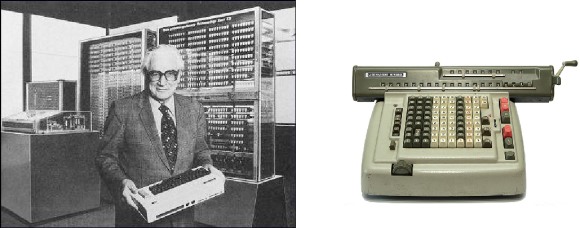
Here something new happened – growth beyond the size of a room. Harvard Mark I was big electro-mechanical machine, put in big hall. Mark I served for Manhattan Project. There was a problem, how to detonate atomic bomb. Well known von Neumann computed explosive lens on it. Mark I was funded by IBM, Watson Sr.

So, electro-mechanical computing started from the size bigger than a man, smaller than a room, and then evolved in two directions: miniaturized to desktop size, and grown to small stadium size.
Electrical Vacuum Tube computing
At some point, mechanical parts were redesigned to electrical, and first fully electrical machine was created – ENIAC. It used vaccum tubes. Its size was bigger than a man, smaller than a big room (left photo). The fully electrical computing technology on vacuum tubes got miniaturized to desktop size (right photo).

Very interesting and beautiful was miniaturization. Even vacuum tubes could be small and nice. Furthermore, there were many women in the indutry at the time of electrical vacuum tube computing. Below are famous “ENIAC girls”, with the evidence of miniaturization of modules, from left to right, smaller is better. Side question: why women left programming?
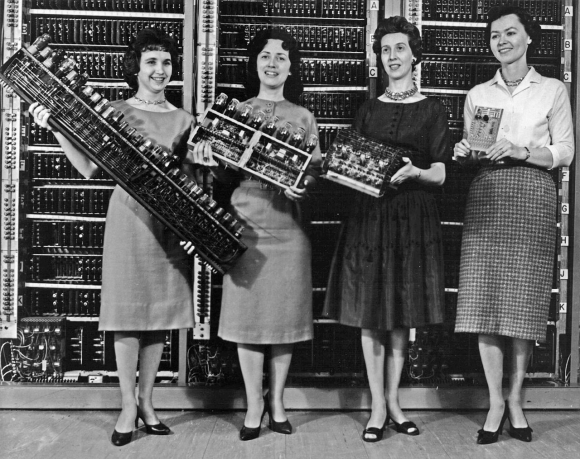
ENIAC was very difficult to program. Here is tutorial how to code the modulo function. There were six programmers who could do it really well. ENIAC was intended for balistic computing. But well known same von Neumann from atomic bomb project, got access to it and ordered first ten programs for hydrogen bomb.

Fully automatic electrical machines grew big, very big, bigger than Mark I, II, III etc. They were used for military purposes, and space programs. IBM SAGE on photo, its size is like mid stadium.
Electrical Transistor computing
First fully transistor machine was build probably by IBM, though there is photo of European [second] machine, called CADET (left photo). There were no vacuum tubes in it anymore. Transistor technology is till alive, very well miniaturized to desktop and hand (right photo).
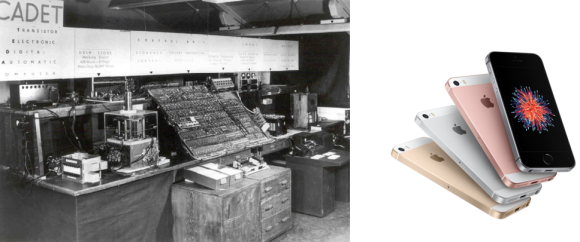
Miniaturization of transistor computing went even further, than size of the hand. Think of small contact lens, small robots in veins, brain implants, spy devices and so on. And transistors are getting smaller and smaller, today 14nm is not a big deal. There is dozen of silicon foundries capable of doing FinFET at such scale.

Transistor computers grew really big, to the size of the stadium. The Earth is being covered by data centers, sized as multiple stadiums. It’s Titan computer on photo, capable of crunching data at the rate of 10 petaFLOPS. The most powerful supercomputer today is Chinese Sunway TaihuLight at 34 petaFLOPS.
But let me remind the point: electrical transistor computing was designed at the size bigger than a man, smaller than a room, and then evolved into tiny robots, and huge supercomputers.
Quantum computing
Designed at the size bigger than a man, smaller than a room.
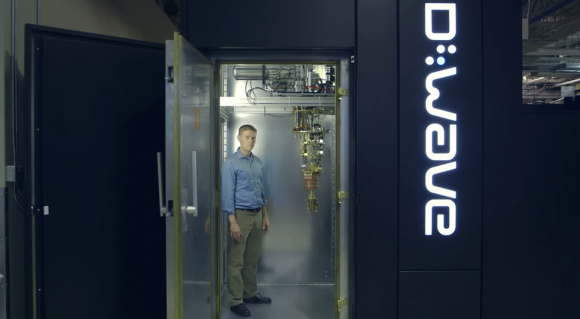
Everything is a fridge. The magic happens at the edge of that vertical structure, framed by the doorway, 1 meter above the floor. There is a silicon chip, designed by D:Wave, built by Cypress Semiconductor, cooled to absolute zero temperature (-273C). Superconductivity emerges. Quantum physics start its magic. All you need is to shape your problem to the one that quantum machine could run.
It’s somewhat complicated excercise, like modulo function for first fully automatic electrical machines on vacuum tubes years ago. But it is possible. You got to take your time, paper and pen/pencil, and bring your problem to the equivalent Ising model. Then it is easy: give input to quantum machine, switch on, switch off, take output. Do not watch when machine is on, because you will kill the wave features of particles.
Today, D:Wave solves problems 10,000x faster than transistor machines. There is potential to make it 50,000x faster. Cool times ahead!
Motivation
Why do we need such huge computing capabilities? Who cares? I personally care. Maybe others similar to me, me similar to them. I want to know who we are, what is the world, and what it’s all about.
The Nature does not compute the way we do with transistor machines. As my R&D colleague said about a piece of metal: “You raise the temperature, and solid brick of metal instantly goes liquid. Nature computes it at atomic level, and does it very very fast.” Today one of Chinese supercomputers Tianhe-1A computed behavior of 110 billion atoms during 500,000 evolutions… Is it much? It was only 0.1 nanosecond corresponding to real time, done in three hours of computing.
Let’s do another comparison for same number of atoms. It was about 10^11 atoms. If it was computed at the rate of 1 millisecond, then it would be only 500 seconds, less than 10 minutes. My body has 10 trillions molecules, or about 10^28 atoms. Hence, to simulate entire me during 10 minutes at the level of individual atoms, we would need 10^18x more Tianhe-1A supercomputers… Obviously our current computing is wrong way of computing. Need to invent further. But to invent further, we have to adopt new way of computing – quantum computing.
Who needs such simulations? Here is counter question – what is Intelligence? Intelligence is our capability to predict the future (Michio Kaku). We could compute the future at atomic level and know it for sure. The stronger intelligence is, the more detailed and precise our vision into the future is. As we know the past, and know the future, the understanding of time changes. With really powerful computing, we know for sure what will be in the future as accurately as we know what happened in the past. Distant future is more complicated to compute as distance past. But it is possible, and this is what Intelligence does. It uses computing to know the time. And move in time. In both directions.
Conclusion
All computing technologies together, on one graph, show some pattern. Horizontaly we have time, from past (left) to future (right). Vertically we have scale of sizes, logarithmic, in meters. Red dot shows quantum computing. It is designed already, bigger than a man, smaller than a room. Upper limits are projected bigger than modern transistor supercomputers. Lower is unknown. It’s OK that both transistor and quantum computing technologies coexist and complement each other for a while.
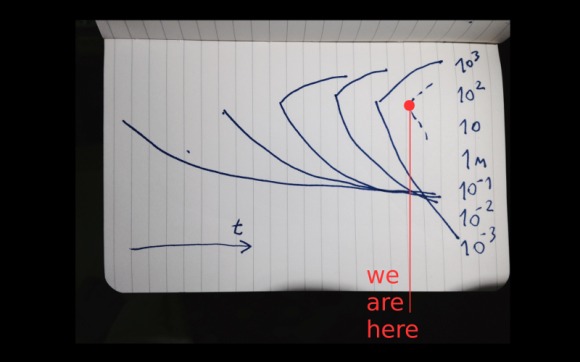
All right, take a look at those charts, imagine quantum lines continuation, what do you see? It is Software is eating the World. Dragon’s tail is on the left, body is in the middle, and the huge mouth is on the right. And this Software Dragon is eating ourselves at all scales. Somebody calls it Digitization.

Software is eating the World, guys. And it’s OK. Right now we could do 10,000x faster computing on quantum machines. Soon we’ll be able to do 50,000x faster. Intelligence is evolving – our ability to see the future and the past. Our pathway to time machine.